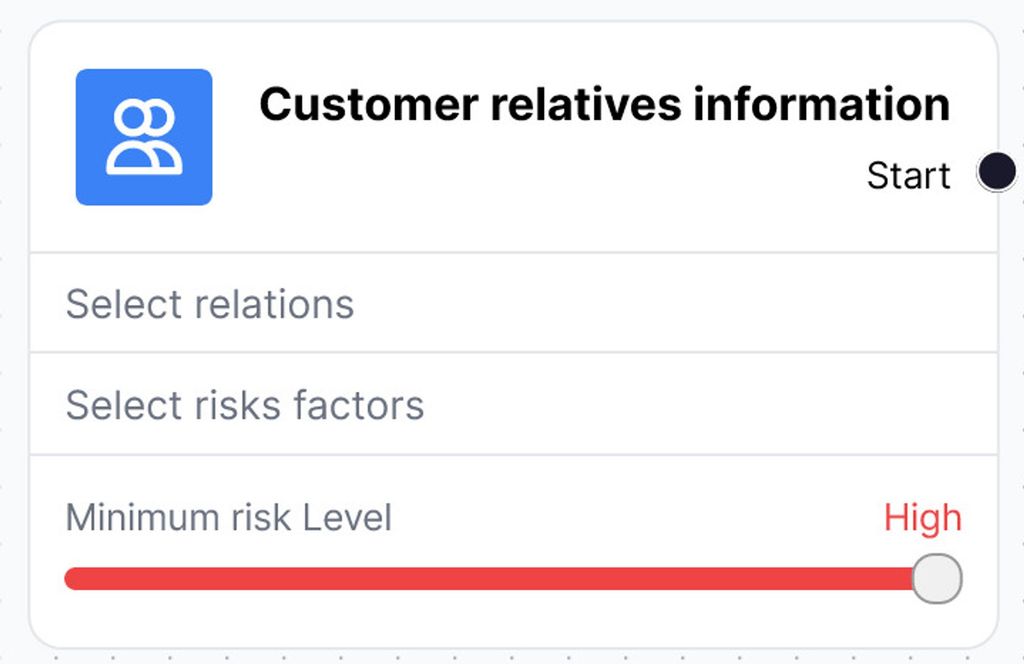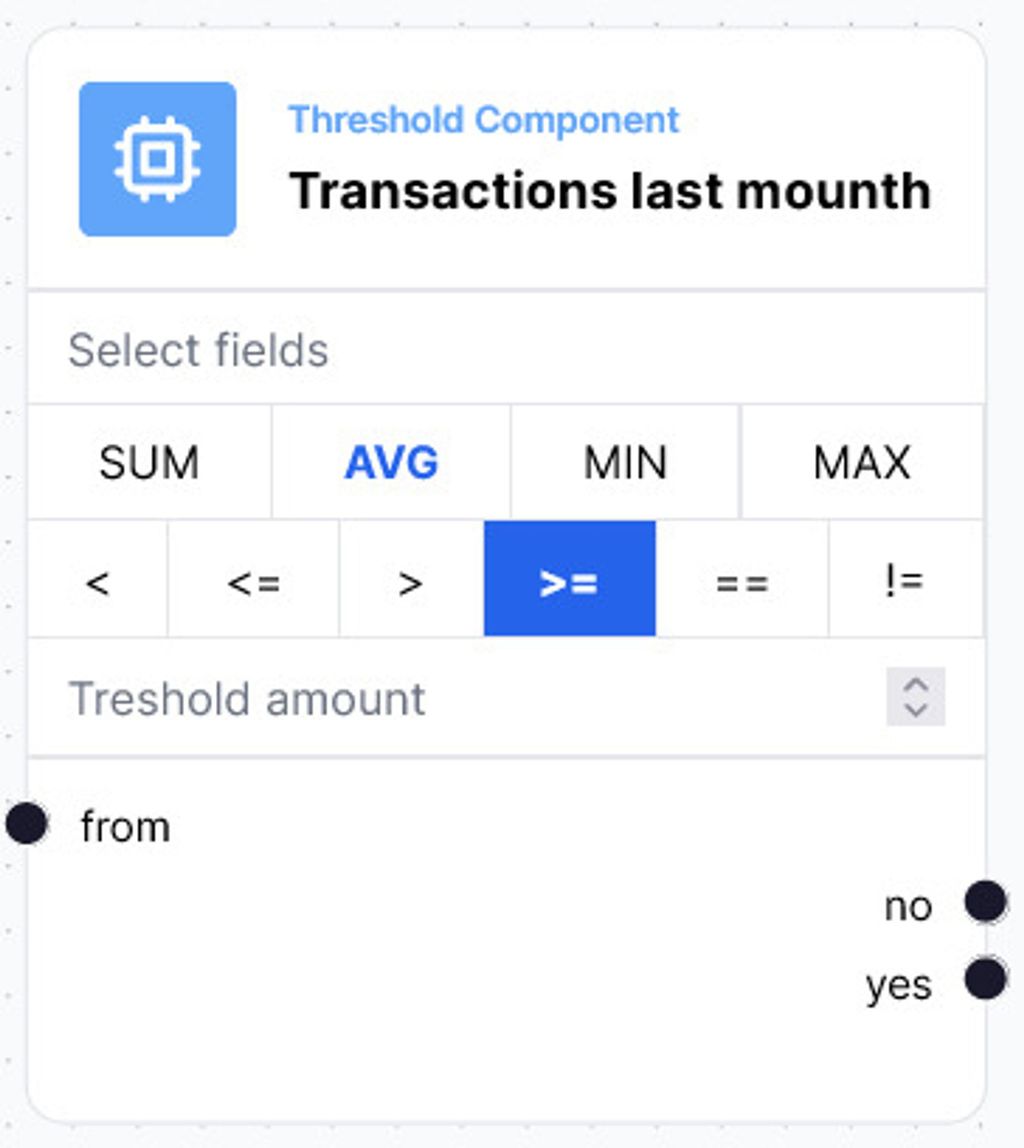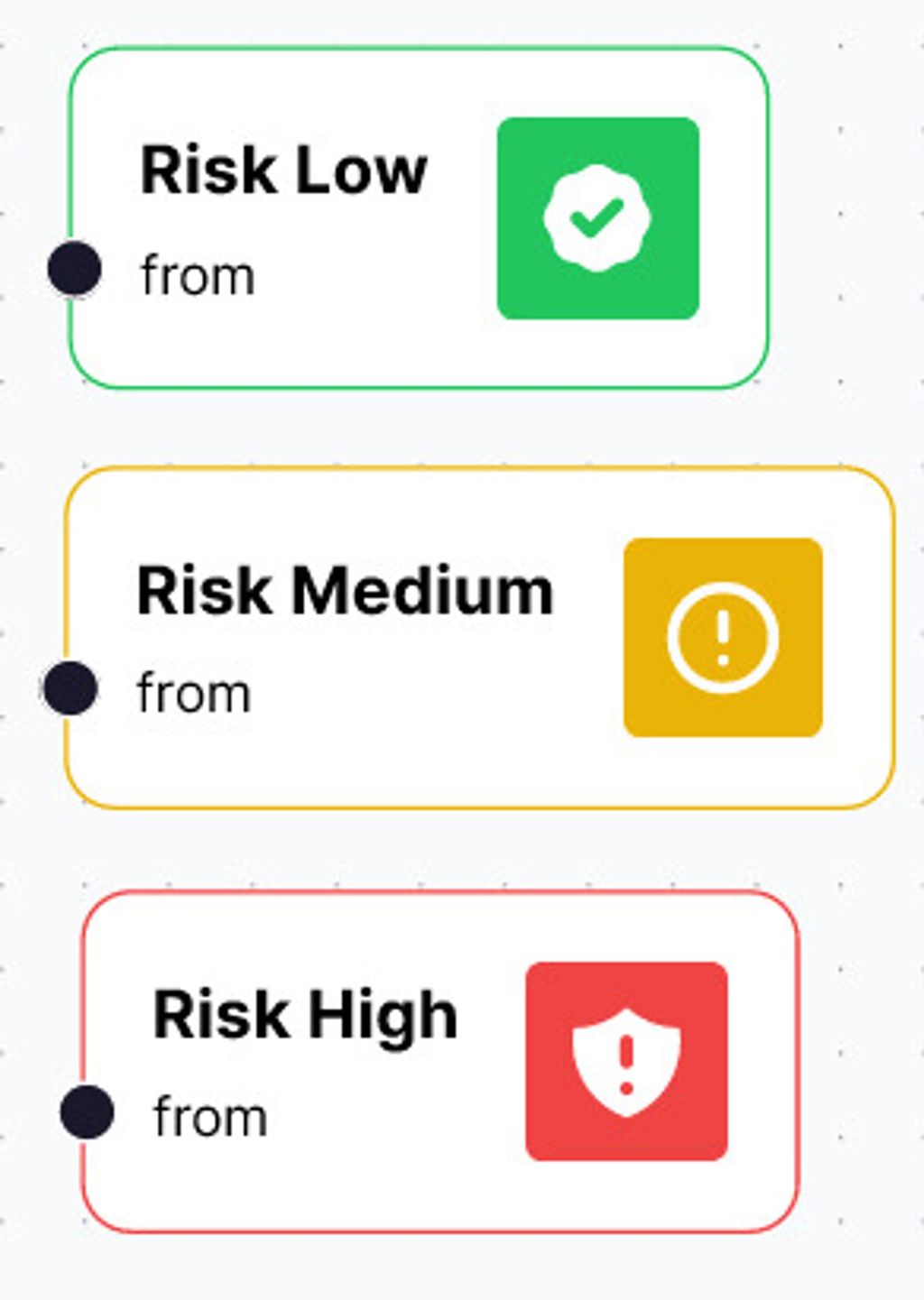
Example of a rule decision tree (Go!Risk)
enc_U2FsdGVkX19lNQZxmm7xqCScmdYVX0MeKvp23gIxq5Aro/K6Sf5bcb63N9ys4fyy_enc
In the context of the “Risk Factors” page, a flow refers to a series of connected nodes or components that are used to analyze and determine the risk level of a customer. There are two types of flows: “Customer Flow” and “Customer Relations Flow.”- A “Customer Flow” starts with a customer component and all subsequent components in the flow are based on customer information. This type of flow is useful for analyzing the risk associated with customer fields.

- A “Customer Relations Flow” starts with a customer relations component and all subsequent components in the flow are based on customer relations information. This type of flow is useful for analyzing the risk associated with a customer based on his relatives information instead of himself.
 💡 It’s important to note that before adding a new risk factor, it’s necessary to first determine the appropriate flow type. This means that you’ll need to decide whether a “Customer Flow” or “Customer Relations Flow” would be more suitable to analyze the risk associated with the factor you’re considering.
💡 It’s important to note that before adding a new risk factor, it’s necessary to first determine the appropriate flow type. This means that you’ll need to decide whether a “Customer Flow” or “Customer Relations Flow” would be more suitable to analyze the risk associated with the factor you’re considering.
enc_U2FsdGVkX1/c3Ll9phzh4RBuiRKW8vVzLcH2O2qOLq8i6IQX2NZ1iWxOwuKSBl/H_enc
There are five main types of components that can be used in the “Risk Factors Flows” (risk factors definitions):enc_U2FsdGVkX182tqQELoMEG9RIHU7YRdVwVbO552gbMjT2cd98hDtd/cpT2NxPH4kT_enc
enc_U2FsdGVkX1/eeFzj4C+UYzcPFly1zmjjisx13niMjWOlRyOXgBy9tLsyZV5sOjRAm+ktYonBUbK9Eu7sStUeANGa8oXmJqlKnXhaij9B9oLBnPCMBARgl/0KB63NfedRnWK9bwdAPK7UQX4IEDuE1hnEleKptAdIqFUCZcmbRaYPukPfA8PlnQvBqA5iTJty3CXpXxMgfHo+YiOkItmZPcEzcrHvx5ZOoDWM46AN4s0=_enc enc_U2FsdGVkX1+OEQtVO13p5RfbF7ShA1E03tKPP5dAMv3raOOPplpF8FbVgOIspGxK6P3YmdDGkiIqaQDx2HxlC1F+S/4O7tINFCECMeIfMpI=_enc Like the types of flow, we have two main start components:- Customer Start Component:
enc_U2FsdGVkX19LzvIPAR5Dn9cnNjlEa+hkLByVjoH6O846iZqvb/aOF6oC595SxphdGkTPOSSyyThzRmj/yMiDgw==_enc
Inputs: N/A
Outputs:
- Start

- Customer Relatives Start Component:
enc_U2FsdGVkX19L8KcQisn8EJEWZIiBnD1nbN8DjIZ58K/OggfLB2Ixq3rtjclnVg1W2AkRzDLrLZ3iDmXn5l0ATBbsEBNWA7sR+JD5lJHwXvU=_enc
Inputs:
- Relations: Filter by type of relations: wife, husband, etc…
- Risk factors: Filter by existing risk factors. Example: PEP
- Minimum risk level: Minimum risk needed for the chosen risk factors (low, medium, high). Outputs:
- Start

enc_U2FsdGVkX1/MHcXmOyudcM4HErjPe/CENCVK4c0ydFI=_enc
A matrix node will compare a variable with a set of values, and output one of four values: “high”, “medium”, “low” or “undefined”. The matrix node works onstrings, numbers and booleans.
It has the following options:
| Option name | Description |
|---|---|
variable | The variable to compare. |
matrix_id | The matrix to use. |
use_regex | If true, the matrix will use regex to match the variable. |
enc_U2FsdGVkX18zQJ8/d1zvA1NTZpkRZm1tnVAcbDFldOY=_enc
The comparison node will compare two variables, and output one of three values: “yes”, “no” or “undefined”. The comparison node works onstrings, numbers and booleans.
It has the following options:
| Option name | Description | Example |
|---|---|---|
variables | The variables code (aggregated to a single value). It can also be a static arbitrary value. | payment_method.code |
comparator | One of the following values: =, !=, >, >=, <, <=, regex. | regex |
value | An arbitrary value used for the final comparison. | /^FR.*$/ |
enc_U2FsdGVkX1+u2TojGUmvLalK4f/eTEqaZWjCntQPFFQ=_enc
The formula node will compute a number result from multiple variables, compare it to a value and output one of three values: “yes”, “no” or “undefined”. The formula node works onnumbers and booleans. Booleans are converted to 0 or 1.
It has the following options:
| Option name | Description | Example |
|---|---|---|
variables | A map of named variables. | converted_amount and 30d_average_amount |
formula | A formula using the variables, the formula must return a boolean value and use valid math function defined here. | (converted_amount - 30d_average_amount) / 30d_average_amount |
comparator | One of the following values: =, !=, >, >=, <, <=. | > |
value | An arbitrary value used for the final comparison. | 1 |
- from
- fields: number custom fields (transactions_amount, age, etc..) on wich the threshold will be applied.
- aggregator operator: specify how the values of the custom fields will be combined, such as summing them together or taking the average.
- comparator operator: specify how the combined value will be compared to the threshold, such as being greater than or less than.
- no: if the threshold condition is false.
- yes: if the threshold condition is true

enc_U2FsdGVkX188ofjfQPWTJsjkuxI5q15KGSJovRtvdao=_enc
The leaf component is the final component in a flow and marks the end of the decision tree. It is used to determine the risk level of a customer. The leaf component comes in three types: Low leaf, Medium leaf, and High leaf. Inputs:- from


